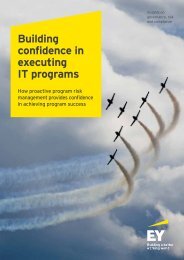Customer lifetime profitability how to grow and manage your best customers
1LOJU6v
1LOJU6v
- No tags were found...
You also want an ePaper? Increase the reach of your titles
YUMPU automatically turns print PDFs into web optimized ePapers that Google loves.
This article is an extract from Performance, Volume 7, Issue 2, May 2015. The full journal is available at<br />
ey.com/performance<br />
<strong>Cus<strong>to</strong>mer</strong> <strong>lifetime</strong> <strong>profitability</strong>: <strong>how</strong> <strong>to</strong> <strong>grow</strong> <strong>and</strong> <strong>manage</strong> <strong>your</strong> <strong>best</strong> cus<strong>to</strong>mers<br />
The core idea behind<br />
CLP is that companies<br />
can improve their<br />
<strong>profitability</strong> <strong>and</strong><br />
lower their costs by<br />
being more cus<strong>to</strong>mer<br />
focused.<br />
T<br />
he development of longterm<br />
profitable relationships<br />
should be a major focus<br />
for all businesses. Markets<br />
are increasingly becoming<br />
competitive, with consumers<br />
actively seeking br<strong>and</strong>s <strong>and</strong> providers they<br />
can rely on <strong>and</strong> keep purchasing from over<br />
many years.<br />
How those relationships are <strong>manage</strong>d<br />
<strong>and</strong> nurtured is the foundation for CLP,<br />
which offers a measure of the underlying<br />
profit for an organization’s cus<strong>to</strong>mer base,<br />
<strong>and</strong> considers the future revenues <strong>and</strong> costs<br />
for the <strong>lifetime</strong> of the cus<strong>to</strong>mer.<br />
Many organizations do not have an<br />
accurate underst<strong>and</strong>ing of which cus<strong>to</strong>mers<br />
are profitable <strong>and</strong> which are unprofitable.<br />
Companies that do are able <strong>to</strong> deploy<br />
strategies <strong>to</strong> acquire <strong>and</strong> retain more<br />
profitable cus<strong>to</strong>mers, <strong>and</strong> increase the<br />
<strong>profitability</strong> of cus<strong>to</strong>mers that are low or<br />
loss-making. These organizations achieve<br />
profit <strong>grow</strong>th more efficiently, retain more<br />
cus<strong>to</strong>mers <strong>and</strong> spend more effectively.<br />
By taking a cus<strong>to</strong>mer-centric view<br />
<strong>to</strong> managing the revenue <strong>and</strong> cost<br />
base, organizations can make decisions<br />
founded on cus<strong>to</strong>mer need <strong>and</strong> deliver<br />
“good profits” derived from improving<br />
cus<strong>to</strong>mer experience <strong>and</strong> advocacy. This<br />
means investing in what matters most <strong>to</strong><br />
cus<strong>to</strong>mers <strong>and</strong>, at the same time, removing<br />
or improving processes that frustrate<br />
cus<strong>to</strong>mers <strong>and</strong> increase an organization’s<br />
costs. Enterprises that adopt this approach<br />
will be rewarded with better cus<strong>to</strong>mer<br />
outcomes as well as improved <strong>profitability</strong>.<br />
What does cus<strong>to</strong>mer value<br />
really mean?<br />
The concept of a cus<strong>to</strong>mer <strong>lifetime</strong><br />
value has been discussed for some time.<br />
What EY has found is that many of the<br />
businesses we work with don’t yet have a<br />
detailed underst<strong>and</strong>ing of the cost-<strong>to</strong>-serve<br />
component of their businesses. The core<br />
idea behind CLP is that companies can<br />
improve their <strong>profitability</strong> <strong>and</strong> lower their<br />
costs by being more cus<strong>to</strong>mer focused.<br />
Those of our clients that have a close<br />
eye on the future work with us <strong>to</strong> extend<br />
CLP <strong>and</strong> focus on acquiring <strong>and</strong> — more<br />
importantly — retaining high-value<br />
cus<strong>to</strong>mers. In the CLP model, gaining large<br />
numbers of cus<strong>to</strong>mers isn’t the focus, but<br />
gaining high-value, long-term cus<strong>to</strong>mer<br />
relationships is. What businesses then see<br />
is a strong positive financial outcome from<br />
CLP, <strong>and</strong> also a strong cus<strong>to</strong>mer services<br />
outcome, which feeds back in<strong>to</strong> CLP.<br />
The foundation of CLP is data. Until fairly<br />
recently, a clear <strong>and</strong> comprehensive insight<br />
in<strong>to</strong> cus<strong>to</strong>mer behavior was quite difficult<br />
<strong>to</strong> develop. Today, thanks <strong>to</strong> research, big<br />
data <strong>and</strong> social media, detailed cus<strong>to</strong>mer<br />
profiling has become possible. CLP, by<br />
extension, is a product of this new insight<br />
<strong>and</strong> the way massive datasets can be<br />
interrogated <strong>to</strong> reveal cus<strong>to</strong>mer behavior<br />
<strong>and</strong>, <strong>to</strong> a large degree, predict future<br />
cus<strong>to</strong>mer behavior.<br />
Yet the surge in big data brings its own<br />
challenges. In particular, the information<br />
crisis that is now facing a significant<br />
proportion of organizations. There are<br />
opportunities for the taking but only for<br />
those businesses that can successfully <strong>and</strong><br />
consistently identify what information is<br />
the most relevant <strong>and</strong> generates the most<br />
value. For those that are unable <strong>to</strong> make big<br />
data work for them, the future will bring a<br />
lack of control.<br />
The vast quantity of data now pouring<br />
in<strong>to</strong> the businesses we work with has<br />
delivered an unprecedented level of<br />
granular insight in<strong>to</strong> cus<strong>to</strong>mer behavior.<br />
This insight is also in real time, which means<br />
companies need <strong>to</strong> be more agile if they are<br />
<strong>to</strong> leverage effectively the information they<br />
have.<br />
More organizations are now focusing<br />
on one-<strong>to</strong>-one cus<strong>to</strong>mer marketing rather<br />
than a model based around mass-market<br />
broadcasts. These are delivered through<br />
analytics, incorporating insights that focus<br />
on personalized solutions <strong>and</strong> the “next<strong>best</strong><br />
action” for the cus<strong>to</strong>mer using triggerbased<br />
scenarios. Pre-empting cus<strong>to</strong>mer<br />
needs improves their experience <strong>and</strong> is a<br />
powerful <strong>to</strong>ol for engagement.<br />
What we are finding is that many of<br />
our clients are beginning <strong>to</strong> realize that<br />
12 Volume 7 │ Issue 2



